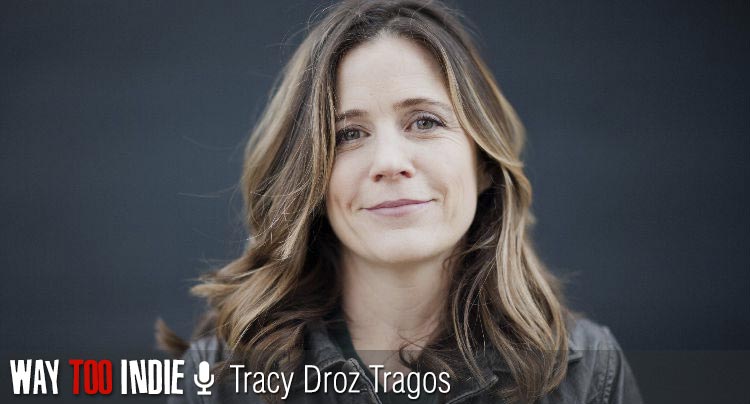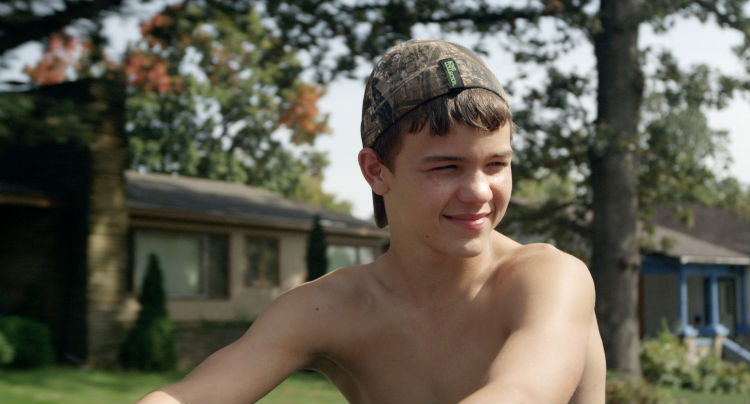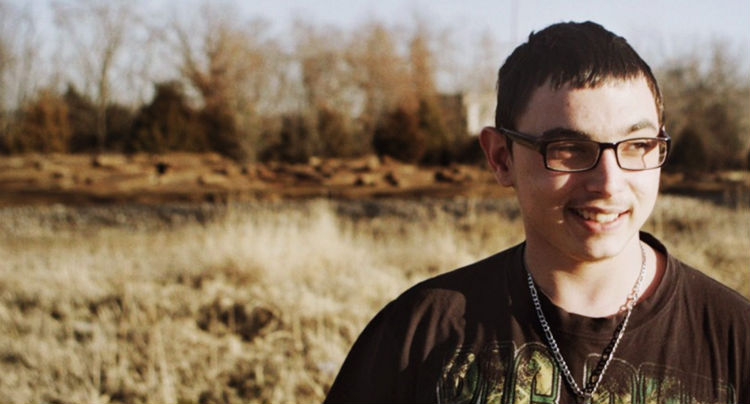Tracy Droz Tragos On Finding Hope and Love in Rich Hill

With her incredible documentary Rich Hill, Tracy Droz Tragos takes us into the homes and minds of three teenage boys–Appachey, Andrew, and Harley–living in poverty in rural Rich Hill, Missouri. The boys’ experiences aren’t atypical; there are thousands of towns just like Rich Hill throughout the country, but rarely do we see such an honest, intimate portrait of the hard circumstances dealt to these families, who deserve our attention as much as any megastar gracing the silver screen.
We spoke to Tracy in San Francisco about misconceptions about small, rural towns, why she chose to film teenage boys, filming the boys like heroes, Harley’s willingness to share dark details about his past, the love shared by the three families, and more. Rich Hill is playing now in select theaters and on demand.

Places like Rich Hill are a part of our identity as a country, but we rarely see communities like it in media. Excuse me if this sounds ignorant, but for someone like me, who grew up in the suburbs of Northern California, it’s almost like a different world.
Tracy: Right. Rich Hill isn’t unique or extreme in any way. It’s like a lot of cities across U.S. that you drive by or fly over. Folks from California and New York may not know much about places like this, but I hope ultimately in our treatment of the film that there is some connection, even if you don’t recognize the place necessarily. Audiences will hopefully feel a connection to the families.
I definitely connected with the familial aspect. The film is very, very cinematic. You obviously see a lot of aesthetic beauty in Rich Hill that perhaps city folk like me wouldn’t see.
Tracy: It’s hard to see past the impoverished aspects of the city–the mess in the yard, the mess in the home. It’s hard to see past that. You immediately push away and don’t want to look deeper. My husband, who has no connection to Rich Hill, didn’t want to go back there for a long time. It’s a hard place to see. But we really wanted to give it a cinematic treatment, and we wanted it to be beautiful. As much as there is hardship, there’s also stuff that can be celebrated and glimmers of potential and hope within these kids and their families. We wanted audiences to see that, too.
Have you seen Jeanne Dielman?
Tracy: No, I have not!
It’s Chantal Akerman’s film, and it’s 200 minutes of a woman doing chores.
Tracy: Is it a documentary?
No! It’s narrative. Her whole statement was that a woman’s work is as worthy of being on the big screen as John Wayne. I get a similar feeling from your film. These people deserve to be on movie screens as much as anyone else.
Tracy: I appreciate that very much. We chose to shoot on a high-end camera and in the way that we did to make these kids and their families heroes. We wanted to shoot from a low angle and give a sense that they could take on the world. There’s this potential in them. We wanted to give them a beautiful movie, not the in-and-out treatment you see in reality TV. That’s a big part of what we’re trying to do, so thanks for that.
Why did you choose to follow kids? Boys, specifically.
Tracy: We chose kids because it’s harder to dismiss them. They still have hopes and dreams. Their parents’ dreams had been checked. These kids still had this optimism. Often, families who are struggling are cast aside because people think it’s their own fault, it’s their own choice that they’re in the circumstances they’re in, or they had some moral failing. We wanted to push past that, and any empathy audiences felt for the kids would hopefully radiate out to their families. In terms of the choice to have it be boys, that wasn’t an original intention, but it was a place the film made sense to be. To tell as intimate a story as we wanted to tell, we had to get pretty darn specific, and the experience of these boys…they had so few role models. Their brushes with the juvenile justice system and their anger felt so specific to their experience, so it felt like that’s where the film needed to be.
The making of this film spawned another film that I’m working on now, the story of a young woman who became pregnant at 15 and now has a six-month-old son. I’m following her and her trajectory. It’s pretty exciting what Linklater did with Boyhood, and this will be five years in the lives of their young family.
I feel like that film will be a great complement to this one, because Rich Hill is about boys, but it’s also about their mothers.
Tracy: Exactly. And this is kind of the prequel to it, because these mothers were all teenagers when they had kids. That robs you of a certain opportunity to be a child, and that makes the parent-child lines blurred. I’m hopeful for Sarah and her son, but they’ve got a tough road ahead of them, and how they navigate that is still to be seen. It’s tough. I was shooting with her two weeks ago, and she wants to go back to 10th grade, but she can’t afford decent child care for her son.
That’s a tough deal. There’s that heartbreaking moment in Rich Hill when Appachey’s mom talks about not being able to have a life because she was a young mother.
Tracy: It is a tough deal. All of the folks in the film…their trajectories have shifted in some way. Experiencing audiences’ reactions and they themselves seeing the film. Appachey’s mom now says that, if she doesn’t have hopes and dreams, her kids won’t either. The film hasn’t fixed everything, but she’s talking about getting her GED and working towards getting a job not in the fast food industry, not for herself, but for her kids.
There’s so much love in the film. The image of Andrew putting his arm around his mom with a big smile on his face is so beautiful because he’s so proud to be her son.
Tracy: Exactly. That’s what he’s talking about at the beginning of the film, when he says “We’re not trash.” That came from a conversation about how people perceive his parents as trash. “We’re not trash; we’re good people.”
He’s always got a smile on his face. Such an optimistic soul.
Tracy: He touched me and continues to touch me with his optimism.
So you stay in touch with the kids?
Tracy: Oh yes. Absolutely. I feel very strongly about the importance of that. They’ve given so much. I couldn’t imagine making this film and then just saying, “See ya!”
There’s a bit at the end of the film where Harley is joking around with you. He’s so quick-witted and charming!
Tracy: His sense of humor is amazing. He’ll come up with something when you least expect it. We sort of broke the fourth wall there at the end, partly because he’d given us so much and been so brave, and we wanted to give him a little bit back.

It’s such a powerful moment when you’re following Harley down the street on Halloween as he talks about his views on rape.
Tracy: What had happened to him came up more than once. That wasn’t the only time. There was this feeling of him wanting to get this off his chest. In part it was to explain, “This is why his mother was in prison, these are the circumstances.” No one in town knew about it, and he didn’t have much of an opportunity to talk about it, so he really wanted this to be in the film and to share this with audiences. We didn’t know where the film would go, but in the best case scenario, it would go out to theaters and television. He still wanted audiences to bear witness to that. It’s something he lives with so close to the surface, and that moment really revealed that.
The film is very transportive; you really make us feel like we’re visitors in Rich Hill. How do you achieve that kind of atmosphere as a filmmaker?
Tracy: Our choice of cinematography–the way we shot, the camera we shot on, the small moments–was important, but it was also our sound design. We worked with Pete Horner at Skywalker, and we talked a lot about the small hand gestures and brining audiences closer using that. We actually ended up doing some foley.
Wow! Give me an example.
Tracy: We particularly used it with Harley and his hand gestures. He plays around with his shirt a lot. The foley was a way of brining you closer to his head space. We wanted a hymnal quality to our score that we hoped wouldn’t bring audiences down and demand you pity these people, but would help you notice the small details and put you in a meditative head space. There were a lot of ways we strove for this to be an intimate, quieter kind of film. The editing is a slow burn that asks audiences to sit back, relax, and go along for the whole ride. We hope audiences will.
What camera did you shoot with?
Tracy: We shot on a RED Scarlet.
Dang!
Tracy: I know, I know! It was a big deal. It was maybe two whole credit cards when we bit the bullet on that one. But yeah, the 4K footage is pretty beautiful.
There are some scenes where you’re shooting in such low light I couldn’t believe it. That must have been a challenge.
Tracy: Yeah, it was. We didn’t light at all. It was a small crew, handheld, and we didn’t want to light. Most of that was because of the intrusion that would create for the families. There were times when the lighting was too low to shoot.
Rich Hill isn’t the most brightly lit town in the world.
Tracy: Folks were living in closets sometimes, and maybe there was one bare lightbulb in the whole house.
The film is totally eye-opening, especially for someone like me who, I must embarrassingly admit, has perhaps been a bit subconsciously dismissive of rural families in poverty. Have you spoken to others who’ve been enlightened by the film in this way?
Tracy: It’s incredible to experience the film with audiences and the families in the film. The families get a feeling of belonging that hey haven’t experienced in their lives, and it’s really great. Having audiences say that they care about their futures really makes a difference. We hope that empathy radiates out to other families like them, who don’t have films made about them, but are just as deserving of some measure of hope, resources, and attention. It starts by making what may be invisible visible.
